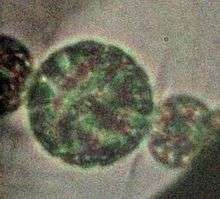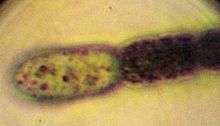Akinete

Intercalary located akinete of Dolichospermum smithii

Terminally located akinete of Gloeotrichia
An akinete is a thick-walled dormant cell derived from the enlargement of a vegetative cell.[1] It serves as a survival structure. It is a resting cell of cyanobacteria and unicellular and filamentous green algae.[2] Under magnification, akinetes appear thick walled with granular-looking cytoplasms.
Development of akinetes from a vegetative cell involves:
- increase in size
- gradual disappearance of gas vacuoles
- increase in cytoplasmic density, number of ribosomes & cyanophycin granules
The akinetes are filled with food reserves, and have a normal cell wall surrounded with 3 layer coat.
References
- ↑ Moore, R. et al. (1998) Botany. 2nd Ed. WCB/McGraw Hill. ISBN 0-697-28623-1
- ↑ Elfgren, I. K. (2003) Studies on the Life Cycles of Akinete Forming Cyanobacteria. Comprehensive Summaries of Uppsala Dissertations from the Faculty of Science and Technology 856, Acta Universitatis Upsaliensis. ISBN 91-554-5665-0
This article is issued from Wikipedia - version of the 6/13/2014. The text is available under the Creative Commons Attribution/Share Alike but additional terms may apply for the media files.